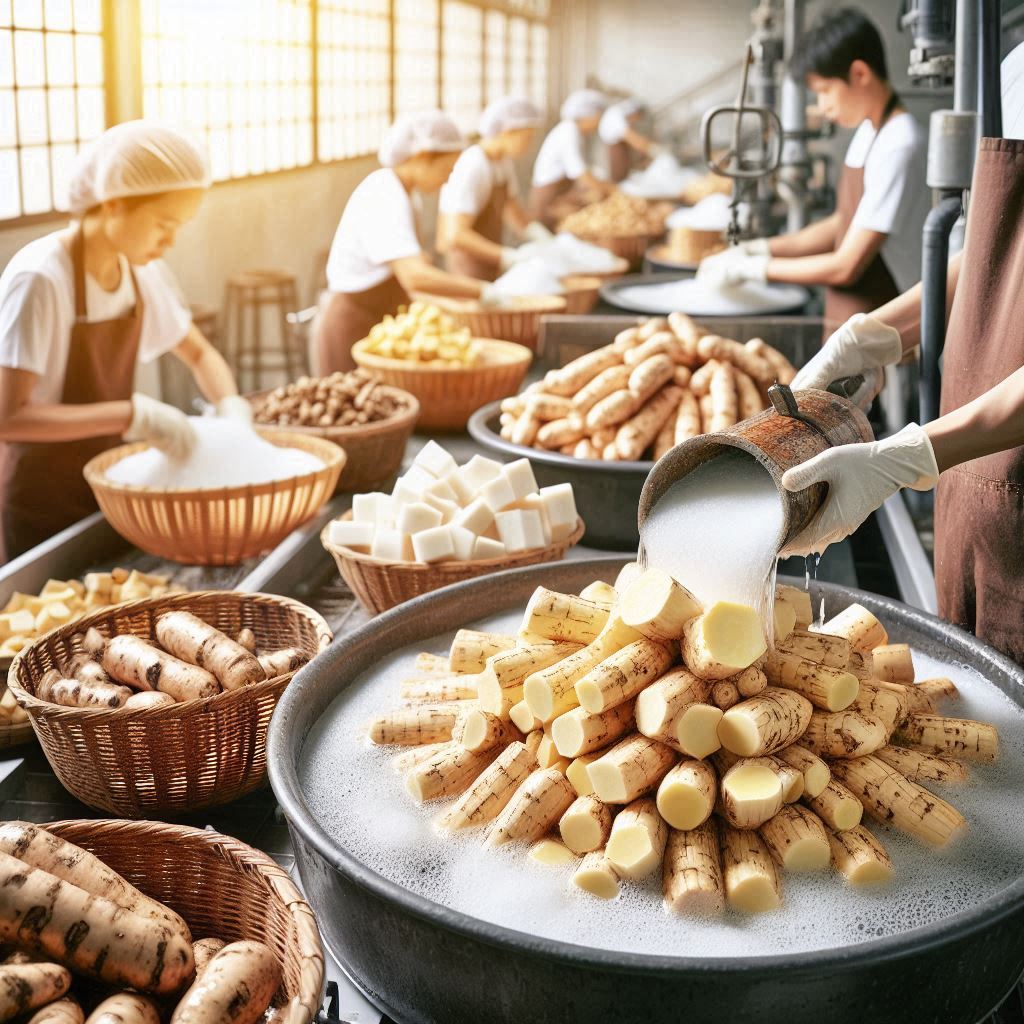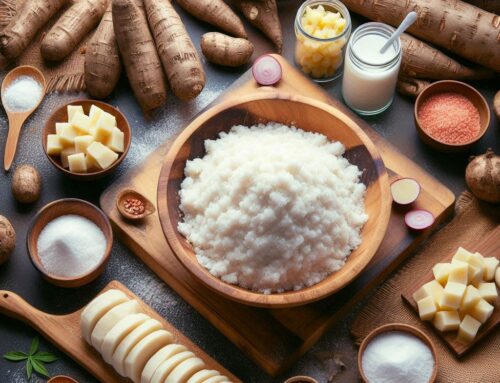
Introduction to Cassava and Its Importance
Cassava, a staple crop in many tropical regions, plays a vital role in global food security and economic development. Known for its resilience and ability to thrive in poor soils and drought conditions, cassava serves as a primary source of carbohydrates for millions of people worldwide. Its tuberous roots are rich in starch, making it an essential dietary component in regions where other crops may fail to grow. Beyond its nutritional contributions, cassava starch holds significant economic value due to its versatility and wide range of applications.
It is used not only as a food ingredient but also in industries such as textiles, paper production, and biofuel manufacturing. The cultivation and processing of cassava provide employment opportunities for rural communities, fostering economic growth and supporting livelihoods. As the world seeks sustainable agricultural practices to meet the demands of growing populations, cassava’s adaptability and multifaceted benefits underscore its importance as both a nutritional staple and an economic asset.
Understanding the Cassava Tubers
Cassava tubers are a staple root crop widely cultivated in tropical regions, primarily valued for their high starch content. These tubers are characterized by their elongated shape and rough, brown skin, encasing a white or yellowish flesh that varies slightly in texture and taste depending on the variety. The composition of cassava includes carbohydrates as the major component, with starch being the most significant constituent. Additionally, cassava contains small amounts of protein, fat, fiber, vitamins, and minerals like calcium and phosphorus.
When it comes to starch extraction, certain varieties of cassava are more favorable due to their higher yield and better quality of starch. Varieties such as bitter or industrial cassava types are often preferred for this purpose because they typically contain higher levels of cyanogenic glucosides that can be removed during processing to produce pure starch efficiently. Understanding these differences is crucial for optimizing the use of cassava in various culinary and industrial applications while ensuring safety and quality in the final product.
Preparing Cassava for Starch Extraction
Preparing cassava for starch extraction involves a series of carefully managed steps to ensure maximum yield and quality. The process begins with the harvesting and cleaning of the tubers, which is crucial as it affects the overall efficiency of starch extraction. Harvesting should be done when the cassava is mature, as this ensures that the tubers have developed their full starch content. After harvesting, it is essential to thoroughly clean the tubers to remove soil, dirt, and other impurities that could contaminate the starch.
Once cleaned, peeling becomes an important step in preparing cassava for optimal starch extraction. Traditional methods often rely on manual peeling; however, mechanical peelers can increase efficiency and reduce time spent on this labor-intensive task. Following peeling, cutting the cassava into small pieces enhances the extraction process by increasing surface area exposure during grinding or grating. This careful preparation lays a strong foundation for effective starch separation and helps in achieving high-quality results in subsequent processing stages.
The Process of Extracting Starch from Cassava
The process of extracting starch from cassava involves several meticulous steps that ensure the purity and usability of the final product. First, the cassava roots are thoroughly washed to remove any dirt or impurities, preparing them for the subsequent stages. Next, the clean roots are grated into a fine pulp using specialized grating tools or machines, which helps in breaking down the fibrous structure and releasing the starch granules. Once grated, water is added to facilitate the extraction process by allowing starch particles to separate more easily from the fibrous material.
The mixture is then subjected to soaking, where it is left in water for a period of time to allow further breakdown and release of starch. Following this, sieving techniques are employed, using fine mesh sieves or cloths to separate the liquid starch slurry from larger fibrous remnants. The collected liquid is then left undisturbed so that gravity can aid in sedimentation; during this stage, heavier starch particles settle at the bottom while excess water can be carefully decanted off. Finally, what remains at this point is pure cassava starch that can be dried and stored for various culinary or industrial applications. Through this systematic approach involving grating, soaking, sieving, and separation methods using water as a vital medium, high-quality cassava starch is effectively extracted for diverse uses.
Drying and Processing Cassava Starch
Drying and processing cassava starch involves several important techniques that ensure the final product’s quality and usability. Once cassava is harvested and its starch extracted, the drying process becomes crucial to prevent spoilage and enhance shelf life. Techniques such as sun drying, flash drying, or using mechanical dryers are commonly employed to remove moisture effectively from the extracted starch. Each method varies in efficiency, cost, and scalability; however, choosing the appropriate technique depends on available resources and desired production scale.
Quality control during the drying process is essential to maintain high standards of purity and consistency; this involves regularly monitoring moisture content and ensuring that contaminants are kept at bay. After achieving optimum dryness, proper packaging is key to preserving starch quality during storage. Options like vacuum-sealed bags or airtight containers can help protect against humidity and pests while extending shelf life. With meticulous attention to these drying processes, quality control measures, and storage solutions, producers can deliver premium cassava starch products to meet market demands effectively.
Applications of Cassava Starch
Cassava starch, derived from the root of the cassava plant, finds a multitude of applications across both culinary and industrial domains. In the culinary world, cassava starch is highly valued as a thickening agent in soups, sauces, and gravies due to its ability to create smooth textures without altering flavor. It is also a popular choice for those seeking gluten-free alternatives; bakers utilize it in gluten-free bread and pastry recipes to achieve desired consistency and elasticity.
Beyond the kitchen, cassava starch plays a significant role in various industrial sectors. In the paper industry, it enhances paper strength and quality by serving as an adhesive or binding agent. The textile industry benefits from its use in finishing fabrics to improve texture and durability. Additionally, cassava starch is increasingly being explored as a renewable resource for biofuel production, contributing to sustainable energy solutions by reducing reliance on fossil fuels. These diverse applications highlight the versatility and importance of cassava starch in both everyday life and broader economic contexts.
Nutritional and Health Benefits of Cassava Starch
Cassava starch, derived from the root of the cassava plant, offers a range of nutritional and health benefits that make it a valuable component in many diets. One of its primary advantages is its high content of dietary fiber, which is essential for promoting a healthy digestive system and preventing constipation. Additionally, cassava starch serves as an excellent source of energy due to its rich carbohydrate content, making it especially beneficial for individuals requiring sustained energy levels throughout the day. Importantly, cassava starch is naturally gluten-free, rendering it suitable for those with celiac disease or gluten intolerance.
This property makes it an ideal alternative to wheat-based products for creating gluten-free recipes without compromising on texture or taste. Furthermore, cassava starch’s versatility allows it to be incorporated into various specific diets that prioritize non-gluten sources or are tailored towards improving digestive health. Overall, the inclusion of cassava starch in one’s diet can contribute significantly to maintaining good health while accommodating specific dietary needs.
Environmental Considerations
Sustainable practices in cassava cultivation are becoming increasingly important as the world seeks to balance agricultural productivity with environmental stewardship. Cassava, a staple crop for millions, offers significant economic benefits, but its farming can impact local ecosystems if not managed responsibly. Implementing sustainable practices such as crop rotation, organic fertilization, and integrated pest management can mitigate these impacts by enhancing soil health and reducing chemical runoff into nearby water bodies.
Additionally, adopting agroforestry techniques can provide shade and preserve biodiversity by integrating trees with cassava crops. The impact of cassava farming on local ecosystems is multifaceted; while it supports food security and livelihoods, it can also lead to deforestation and habitat loss if expansion is uncontrolled. By prioritizing environmentally conscious methods, farmers not only safeguard the land for future generations but also contribute to the global efforts against climate change. These sustainable strategies ensure that cassava cultivation remains a viable and eco-friendly option that harmonizes agricultural needs with ecological preservation.
Conclusion
The extraction of cassava starch plays a pivotal role in numerous industries, making it an essential component in both food and non-food sectors. Its versatility extends to various applications, ranging from serving as a thickening agent in culinary dishes to being a primary ingredient in biodegradable products. Recognizing this importance underscores the need for efficient and sustainable practices in cassava farming and processing. By embracing eco-friendly methods, farmers can ensure the long-term viability of cassava production while minimizing environmental impact.
Encouraging sustainable practices not only preserves natural resources but also supports local economies by providing consistent quality and yield. This approach benefits all stakeholders involved, from farmers to consumers, fostering a cycle of responsible production and consumption that can sustain future generations. In conclusion, prioritizing sustainability in cassava cultivation and processing is crucial for maintaining its valuable contributions across various domains while safeguarding our planet’s health.






